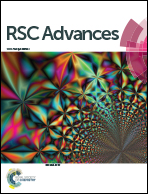Structure evolution of Prussian blue analogues to CoFe@C core–shell nanocomposites with good microwave absorbing performances
Abstract
Novel uniform CoFe@C core–shell composite nanoparticles with good distribution have been fabricated through the combined self-assembly and controlled thermal decomposition of Co-based Prussian blue (PB) nanocubes. Good intrinsic magnetic properties including a high saturation magnetization of 90.9–182.5 A m2 kg−1 and a high coercivity of 192–510 Oe are achieved for these CoFe@C nanocomposites. Excellent wave absorbing properties, including a minimum reflection loss value of −43.5 dB at 9.92 GHz with a sample thickness of 2.5 mm and an effective absorption bandwidth of 4.3 GHz (below −10 dB), are obtained for the CoFe@C nanocomposites, which can be ascribed to the good magnetic properties originating from CoFe as the core and the good electrical conductivity from the graphite carbon layers. These CoFe@C nanocomposites also show good structural stability and low density, which further increases their potential for application as high-performance electromagnetic wave-absorbing materials.


 Please wait while we load your content...
Please wait while we load your content...